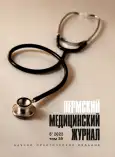Unfavorable maternal outcomes: age structure and territorial distribution
- Authors: Berseneva S.N.1, Isaeva N.V.2, Padrul M.M.2, Chercasova E.V.3
-
Affiliations:
- Perinatal Center of Perm Regional Clinical Hospital
- Perm State Medical University named after Academician E.A. Wagner
- Ministry of Health of the Perm Region
- Issue: Vol 39, No 5 (2022)
- Pages: 132-138
- Section: Preventive and social medicine
- URL: https://journals.rcsi.science/PMJ/article/view/112490
- DOI: https://doi.org/10.17816/pmj395132-138
- ID: 112490
Cite item
Full Text
Abstract
Objective. To analyze and evaluate the factors connected with age and territorial distribution among women with unfavorable maternal outcomes.
Materials and methods. A retrospective epidemiological analysis of official statistics data on all cases of unfavorable maternal outcomes (deceased women and women with near-miss – "almost dead") by age and structure at the place of residence (city, village) in comparison with successful outcomes in Perm Krai (PK), Privolzhsky Federal Region (PFR) and the Russian Federation (RF) for 1997–2020 was carried out.
Results. In the age structure of deceased women in PK, the main share of 46.7 % was occupied by women aged 20–29 and 30–39 years, that differed from the comparison group. Among the mothers with successful outcomes in PK, PFR and RF, women aged 20–29 years were in the first place – 59.3, 62.5 and 60.2 %, respectively, that is 1.3 times higher than the corresponding proportion in MM. In the second place, there were women aged 30–39 years – 29.6; 27.9 and 29.1 %, respectively, that is 1.6 times less than the deceased women of the corresponding age. The percentage of young mothers aged 15–19 was 9.2; 7.7 and 8.9 %, respectively, that is 1.4 times higher than that of the deceased women.
The age structure of women with failed maternal mortality (FMM) differed slightly from that of deceased women and significantly – from all puerperas in PK, PFR, RF. Thus, according to the ave-rage long–term data, the main share of women with FMM was women aged 20–29 years – 51.8 %. The percentage of puerperas aged 20–29 years in PK, Privolzhsky Federal Region and the Russian Federation was 59.3, 62.5 and 60.2 respectively. In the second place in PK are women with FMM aged 30–39 years – 31.5 %. The share of puerperas aged 30–39 years in PK, PFR and RF is 29.6 %, 27.9 % and 29.1 %, respectively. In the third place, there are young puerperas with FMM aged 15–19 years – 14.8 %. The proportion of such patients in PK, PFR and RF is 9.2, 7.7 and 6.6 %, respectively.
According to the average long–term data, the proportion of urban residents prevailed among the deceased women – 60.0 %. In the rural areas, the proportion of women who died was 40.0 %.
By the place of residence, the share of women with FMM did not differ from the corresponding data in the MM group and amounted to 57.4 % in the city and 42.6 % in the village. In PK, PFR and RF, this ratio was 72.7 and 27.3 %; 71.6 and 28.4 %; 73.3 and 26.7 % respectively in all the compared territories).
Conclusions. The risk groups for MM and FMM were women aged 20–29 years, residents of the city and village, high-risk group – rural women 30–39 years.
Full Text
##article.viewOnOriginalSite##About the authors
S. N. Berseneva
Perinatal Center of Perm Regional Clinical Hospital
Author for correspondence.
Email: bers.s2014@yandex.ru
gynecologist
Russian Federation, PermN. V. Isaeva
Perm State Medical University named after Academician E.A. Wagner
Email: bers.s2014@yandex.ru
MD, PhD, Professor, Head of the Department of Public Health and Healthcare№ 1
Russian Federation, PermM. M. Padrul
Perm State Medical University named after Academician E.A. Wagner
Email: bers.s2014@yandex.ru
MD, PhD, Professor, Head of the Department of Obstetrics and Gynecology № 1
Russian Federation, PermE. V. Chercasova
Ministry of Health of the Perm Region
Email: bers.s2014@yandex.ru
MD, PhD, Deputy Head of the Department of Organization of Medical Care to Children Population and Obstetrics, Rehabilitation and Palliative Care, Head of the Departemnt of Obstetrics and Organization of Reproductive Technologies
Russian Federation, PermReferences
- Aylamazyan E.K., Kulakov V.I., Radzinsky V.E., Savelyeva G.M. Obstetrics: nats. Manual. Moscow: GEOTAR-Media 2009; 1200.
- What lies behind the numbers. Study of maternal mortality and complications in order to ensure a safe pregnancy. WHO Bulletin. Department of Reproductive Health 2004; 176.
- Oliveira L.C., Ribeiro A.A., Gesta D. Obitas fetais e neonateis entre casos de near-miss vnaterno. Revista de Associocio Medica Brasileira 2013; 59 (5): 487.
- Camargo S., Pacagnella R.C., Cecatti J.G. et al. Subsequent reproductive outcome in women who have experienced a potentially life-threatening condition or a maternal near miss during pregnancy. Clinics (Sao Paulo) 2011; 8 (66): 1367–1372.
- Souza J.P., Cecatti J.G., Haddad S.M. et al. on behalf of the Brazilian Network for Surveillance of Severe Maternal Morbidity Group and Brazilian Network for Surveillance of Severe / Maternal Morbidity The WHO Maternal Near-Miss Approach and the Maternal Severity Index Model (MSI): Tools for Assessing the Management of Severe Maternal Morbidity. PLoS One 2012; 7 (8): e44129.
Supplementary files









